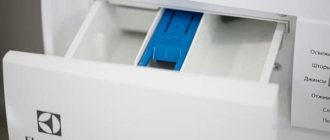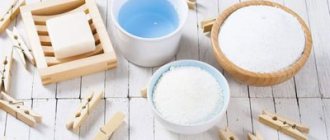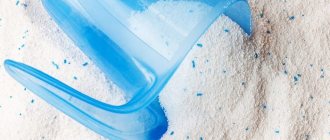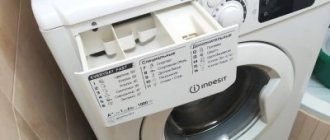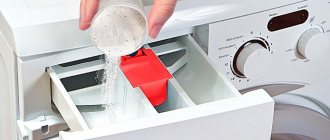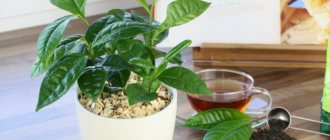Washing powder is still the most popular means for washing all kinds of things in a washing machine and by hand, so many housewives will find it useful to know how many grams of washing powder will fit in a teaspoon and a tablespoon, and how it can be quickly measured without scales using just spoons at home.
Important: below are the data for spoons with powder without a heap, since when you put washing powder into a spoon with a heap, the accuracy of measurement is significantly reduced (the volume of the heap may be different for everyone, especially if the powder is a little damp - in this case the heap can be 3 -5 times the volume of a spoon).
How many tablespoons are in 100 g?
And if you are interested in 100 grams - this is how many tablespoons, then know that it is four.
Interesting materials:
What can I do to prevent pills from appearing on my coat? What to do to heat up the thermometer? What to do to pump up your neck? What to do to avoid an accent? What can I do to avoid itching from glass wool? What to do to prevent the fabric from becoming electrified? What can I do to keep my laptop monitor from going dark? What to do to avoid getting drunk at a party? What can you do to prevent your avocado from turning black? What to do to prevent laundry from fading?
Why measure out powder?
Why you need to accurately measure SMS (synthetic detergent):
- Saving. When using concentrated products, it is easy to make big mistakes. If you put a lot of powder, washing will cost more.
- Washing quality. If, due to the underweight of the product, the dirt cannot be washed off the first time, you will have to start the SMA again, again wasting water and electricity.
Manufacturers of powders and gels can add measuring spoons or cups to the product kit, but only some SMS are equipped with them. If the dosage is indicated on the package in grams, you have to measure out the required amount. You can use scales, but not every kitchen has them and not everyone wants to bother with them. It’s easier to use a spoon or “Tide” - because it’s always at hand.
In cooking and folk medicine, a teaspoon or a tablespoon is a favorite measure of weight and volume indicated in recipes. It is easy to find tables on the Internet that indicate the weight of various substances measured with spoons - salt, soda, pepper, etc. And we will learn how to measure the required amount of SMS with them.
How many spoons of powder should I pour into the washing machine?
To calculate the number of spoons - tea spoons, dessert spoons or table spoons, you need to have three data:
- how many grams are in one spoon - we have already clarified this question;
- dosage specified by the manufacturer;
- drum volume.
If you read the instructions for the detergent, you can find instructions on how many grams to put in 10 liters of water. Considering that different amounts of water are used for washing, you have to make a small calculation. Modern SMAs provide automatic measuring of everything - water and powder, according to the weight of the loaded laundry. If you have to measure SMS yourself, the easiest way is to listen to the advice of experts; they recommend:
- Place 40 grams per 6 kg load. It is most convenient to use the dessert version - you will need to measure 4 pieces. This volume also corresponds to 8 tsp.
- For 1 kg of laundry, sprinkle 1 tbsp. l. no slide. If the water is hard, increase the dosage by 20 grams.
True Powder Dosage
In general, it is better to read dosage recommendations not on the packaging of the powder or in the instructions for it, but from independent sources. Because on average, manufacturers overestimate the required dose of powder by 10%-15% in order to increase their profits. Therefore, you will have to find out the optimal parameters for you personally.
We repeat again, do not try to play it safe and pour as much powder into the compartment as possible. This will not make things cleaner, and there are several other negative consequences:
- it is extremely difficult to rinse dry powder, and even in large quantities, resulting in whitish stains on clothes;
- an unpleasant smell of chemicals in the drum, which will not disappear and will remain on other things;
- tray clogged.
In addition, washing parameters play a huge role in dosage. For example, temperature, type of fabric, nature of contamination and other conditions. With experience, housewives quickly figure out how much powder is needed in a given case, so don’t worry. Through trial and error, you will sooner or later determine the optimal volumes.
One rule always works for any fabric and any washing program: the higher the water temperature, the less powder. If you wash at 30 degrees with rinsing, the dose can be increased.
Interesting:
- Dishwashers for dining rooms
- Washing powder consumption per 1 kg of laundry in a washing machine...
- How much powder should I put in the washing machine?
- How to wash kitchen towels - no stains!
- How much does a dishwasher weigh?
- What brand of washing machine should I buy?
Reader comments
- Share your opinion - leave a comment
How much liquid powder should I pour into the machine?
Many of them have practically established that to effectively wash clothes, it is enough to add 2-3 tbsp. l. facilities. This quantity is suitable for machines with a load of 5–6 kg and a water consumption of 35–50 l.
Interesting materials:
What kind of sand for art concrete? Which beach is on the Black Sea? What approach allows us to highlight the main results of training and education in the context of key tasks? Which train is considered high speed? Which pole of the magnet is positive? Which peninsula is the largest in area Arabian Indochina Kamchatka? What breed is the cat Matroskin? What breed is the Crookshanks? What constant morphological feature does the adverb have? What was Valentina Vladimirovna Tereshkova’s call sign?
Washing parameters and dosage
The amount of detergent required for high-quality washing of stains is influenced by the following factors:
- Temperature. Hot water means less SMS consumption.
- Degree of pollution. Dirtier laundry means more dose.
- Hardness of water. Hard water - high doses.
- Amount of laundry . More loading - more SMS for washing.
- Water consumption per cycle. As water consumption increases, SMS consumption increases.
- Washing program and fabric type. Selected individually. It is recommended to wash wool and silk with special products.
It is always useful to know how much of a particular substance is contained in the most popular cutlery. A simple spoon can be useful in a variety of situations. When placing SMS into a cuvette, try not only to measure the dose correctly, but also take into account as many factors as possible that influence the wash.
Liquid and viscous products
Products in liquid form are measured in either milliliters or grams. Both of these measures can be found in culinary recipes. In a tablespoon, the volume (ml) and weight (g) of many popular liquids in cooking have long been determined and summarized in tables. The hostess can only look into them and use this cutlery to measure the required amount for her dish - be it in milliliters or grams.
Here is a table of the content of liquids and viscous products in a tablespoon in grams. It will not be possible to pour liquid into a spoon above its edges, so the maximum amount of food is limited to these edges. But some viscous ingredients can be placed in heaps, for example, thick honey or homemade high-fat sour cream. This is why the table below shows two weights for viscous products.
Not all that glitters is gold: how to make silver and cupronickel cutlery shine
Table of the weight ratio of liquid and viscous products contained in a tablespoon, in grams.
| Products | grams in tablespoon | Maximum total number of products |
| Water | 18 | — |
| Raw milk | 20 | — |
| Condensed milk | 28 | — |
| Vinegar | 15 | — |
| Melted butter | 17 | — |
| Melted margarine | 15 | — |
| Vegetable oil (sunflower) | 17 | — |
| Liquid fat | 20 | — |
| Liquid jam (average) | 35 | — |
| The jam is thick (on average) | 45 (without slide) | up to 60 |
| Liquid honey | 35 | — |
| Honey is thick | 50 (without slide) | up to 70 |
| Heavy cream | 30 (without slide) | up to 50 |
| Thick sour cream | 30 (without slide) | up to 50 |
| Low-fat sour cream | 25 | — |
| Mayonnaise | 20 (without slide) | 30 |
| Tomato paste | 30 (without slide) | 40 |
| Cottage cheese (on average) | 20 (without slide) | 35 |
It should be said that a standard measuring tablespoon is taken to be a product whose scoop length is 7 cm, and the width of its widest part is 4 cm. This is the kind of spoon that is mentioned in cooking. If anyone does not know whether there is a standard spoon at home, then you can take any other one and measure it by placing or pouring the product into some vessel whose volume is known. By counting the number of spoons required to fill the vessel, it is easy to find out how much product in grams fits in 1 spoon of a given type.
Dry yeast
It’s rare to meet a housewife who doesn’t spoil her family with baked goods. The secret to delicious pies is properly prepared dough that contains yeast. Most modern women use a quick version of this product - dry powder. A teaspoon contains 3-5 g of yeast if you weigh it on a special scale. The specific amount depends on whether the substance is measured with or without a slide.
Washing machine cycles and powder
There are several factors that determine how many grams of product are needed for a particular wash. The main ones:
- the degree of contamination of things and existing stains;
- hardness of the water used for washing.
When using hard water, use special products that contain a softening agent.
- Benefits, harms, nutritional value, calorie content of sour cream per 100 grams, 1 tablespoon, 1 teaspoon
Washing powder dosage
The dosage of washing powder depends on the following factors:
- how much laundry will be loaded for one wash;
- how much water is consumed during one wash;
- what washing machine mode is used;
- type of fabrics.
For washing delicate items, silk and woolen fabrics, it is recommended to use special chemicals.
How to dose washing powder
The table shows the ratio of powder norms based on the loading volume of the washing machine.
Stain removers are used to remove stains of various types. If the fabric is white, use oxygen bleach.
How many grams in a teaspoon table
If 1 teaspoon of flour is indicated, then this means a slightly heaped spoon. Accordingly, recipes may also prescribe 1 small level spoon of flour, then that’s how it should be.
- How much soda in a teaspoon and in a tablespoon
Bulk products
| Product | No slide | With a slide |
| Cocoa powder | 9 | 12 |
| Buckwheat | 7 | 10 |
| Starch | 6 | 9 |
| Dry mustard | 4 | 7 |
| Dry yeast | 5 | 8 |
| Raisin | 7 | 10 |
| Gelatin | 5 | 8 |
| Ground cinnamon | 8 | 12 |
| Ground coffee | 7 | 9 |
| Instant coffee | 4 | 5 |
| Cereals (barley, pearl barley) | 8 | 11 |
| Cornflakes | 2 | 4 |
| Lemon acid | 5 | 8 |
| Poppy | 8 | 12 |
| Semolina | 8 | 12 |
| Powdered milk | 12 | 14 |
| Potassium permangantsovka | 15 | 18 |
| Flour | 9 | 12 |
| Cereals | 6 | 8 |
| Nuts | 10 | 13 |
| Ground pepper | 5 | 8 |
| Rice | 5 | 8 |
| Baking powder | 5 | 8 |
| Rock salt | 8 | 12 |
| Sugar (and its powder) | 7 | 10 |
| Soda | 7 | 10 |
| Extra salt | 7 | 10 |
| Ground crackers | 5 | 7 |
| Sorbitol | 5 | 7 |
| Dry cream | 5 | 6 |
| Dry mashed potatoes | 10 | 12 |
| Beans | 10 | 12 |
| Medicinal herb | 2 | 3 |
| Lentils | 7 | 9 |
| Egg powder | 10 | 12 |
| Tea | 2 | 3 |
Liquid products
Liquid products (water, milk, vinegar) need to fill the spoon completely. It is worth noting that the grams given are relative, so if you need to know the exact weight, it is better to use an electronic or kitchen scale.
| Product | gram |
| Peanut paste | 8 |
| Water | 5 |
| Jam | 17 |
| Red caviar | 7 |
| Potassium permangantsovka | 5 |
| Honey | 10 |
| Mayonnaise | 10 |
| Liquor | 7 |
| Whole milk | 5 |
| Condensed milk | 12 |
| Vegetable oil | 5 |
| Butter | 5 |
| Melted margarine | 4 |
| Fruit puree | 17 |
| Sour cream | 10 |
| Cottage cheese | 4 |
| Soy sauce | 5 |
| Tomato paste | 5 |
| Apple vinegar | 5 |
Why is an overdose of SMS unprofitable?
If you read what is written on the package, it is easy to get confused and make mistakes. There is an opinion that manufacturers deliberately inflate doses so that consumers use up the pack as quickly as possible. In this simple way, the manufacturer increases income by about 10%.
It is not advisable to exceed the dose, things will not wash out better, but the negative consequences of an overdose will be:
- Rinsing dry matter is always a difficult task, and if it is put in excess, it becomes much more complicated. And if you don’t turn on an additional rinse - and this again means extra consumption of water and electricity, then white stains will appear on the fabric - signs of an overdose.
- A chemical “amber” will “start up” inside the drum. It persists for a long time, being transferred to the laundry during subsequent washes.
- The tray is clogged.
Frequently asked questions
Users who do not understand weights and measures often encounter problems when measuring detergents. They have questions:
- Users often ask whether 10, 30 or 50 mg is how many teaspoons? You should remember how many milligrams are in 1 gram. One gram contains 1000 mg, so to measure out this amount of product, you will most likely need a knife. 50 mg = 0.05 g, this is a hundredth part of 1 tsp. This amount is usually about.
- 30 grams of powder is how many spoons? The answer is, depending on which ones. If there are tea glasses, then 6, if dessert ones - 3. With table drinks it is more difficult - you need to measure one incomplete, without 5 g.
Citric acid
Many people are not aware of how widely this substance is used. Citric acid is added to desserts, drinks, mousses, meat marinades, sauces, and soups. A small amount gives a fresh, original taste to a dish, but if you add too much of this substance, you can ruin everything irrevocably. It is worth remembering the proportion and strictly observing it: 5 g of citric acid is placed in a teaspoon. The required amount of this substance is the secret of successful preservation and preparation of delicious dishes.
To make your favorite drink aromatic and tasty, you need to know the exact amount of coffee. It is calculated for instant and natural ground. The weight of a teaspoon of the substance depends on the type of product. Natural ground coffee in a teaspoon in grams - 8. It is difficult to prepare a drink according to professional recipes without exact proportions, so you need to remember them. If you weigh instant coffee of the same volume, you will get no more than 6 g, because it is much lighter than ground grain.
Oils
Modern hypermarkets offer customers olive, sunflower, corn and many other types of oil. Each individual species has its own characteristics and chemical composition. The oil is used to prepare first courses, desserts, meat, and baked goods. You should not add more of this substance than normal; it is important to maintain the proportions to obtain not too fatty, healthy food. How much oil is in a teaspoon depends on the specific type. The average is 6 g.
Powders are still the most popular laundry detergents. In order to wash clothes well without using too much detergent, users try to accurately measure the dose specified by the manufacturer. Let's find out how many grams of powder are in a spoon - the simplest measuring device available in every home.
Sahara
Another popular component of various dishes is granulated sugar. It is worth noting that it is used not only for drinks and desserts, but also unusual side dishes, fish, meat, sauces, and milk porridges. Sugar in a teaspoon in grams is only 5 g, if you take it without a slide, and 7 g if you weigh the volume with a slide. It is important that this substance is used in moderation so that the dish does not become cloying or, conversely, bland.
This amazing beekeeping product is famous not only for its excellent taste, but also for its beneficial properties. In order not to spoil a dessert, sauce, drink, or marinade with honey, it is important to know the proportions of this substance. There is 9 g of honey in a teaspoon, provided that it is fresh and liquid. The specific gravity of the crystallized product will be different: the recipe must be adjusted. You can find out exactly how many grams are in a teaspoon of a particular type of product from special tables, but it is better to weigh the candied sweetness.


